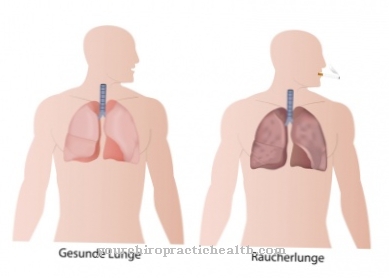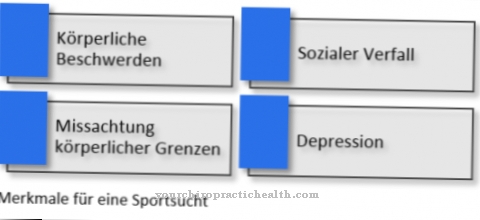Under a Respiratory distress syndrome of the newborn is understood to be a pulmonary dysfunction in infants. Premature babies are particularly affected.
What is Newborn Respiratory Distress Syndrome?
The Respiratory distress syndrome of the newborn (ANS) also bears the names Respiratory distress syndrome in premature babies, Surfactant Deficiency Syndrome, hyaline membrane syndrome or Infant Respiratory Distress Syndrome (IRDS).
What is meant is a lung dysfunction in newborn children that often leads to death. Pulmonary disease manifests itself after birth and is due to immaturity of the lungs. Overall, one percent of all newborn children are affected by respiratory distress syndrome.
The proportion of the disease is particularly high in premature babies and is around 60 percent. Induction of lung maturity made it possible to reduce the death rate from ANS. However, if a respiratory distress syndrome occurs before the 28th week of pregnancy, the death rate is still very high.
causes
The American pediatrician Mary Ellen Avery (1927-2011) discovered the cause of the development of respiratory distress syndrome in newborns in 1959, which enabled targeted treatment methods. The doctor discovered that a surfactant deficiency in the lungs is responsible for the severe dysfunction. The English made-up word surfactant means "surface-active substance" in German.
This substance is usually produced from the 35th week of pregnancy. In around 60 percent of all affected children, however, the respiratory distress syndrome shows up before the 30th week of pregnancy. Up to this point in time, the type 2 pneumocytes within the lungs could not produce sufficient surfactant, which is a surface film. With every breath, this surface film supports the development of the alveoli (alveoli).
Since premature babies are not yet equipped with sufficient lung maturity due to their early birth, the respiratory distress syndrome of the newborn is particularly common in them. If the risk of premature birth is known, the ANS can be counteracted by administering glucocorticoids during pregnancy. The drugs administered have the ability to accelerate the baby's lung maturity.
Symptoms, ailments & signs
Symptoms of the newborn's respiratory distress syndrome are typical. This includes accelerated breathing for the child, who has a breathing rate of more than 60 breaths per minute. The breathing activity of the newborn is more difficult, which can be perceived as a moan when exhaling.
In addition, breathing pauses occur again and again. Other features of the ANS that appear immediately after birth are pale skin, bluish discoloration of the skin (cyanosis), nasal alar breathing, drawing in of the spaces between the ribs, the area below the larynx and the upper abdomen when inhaling, and decreased muscle tone.
Possible acute complications in the newborn's respiratory distress syndrome include the accumulation of air in the body cavities and the development of interstitial emphysema.
Diagnosis & course of disease
The newborn's respiratory distress syndrome is usually diagnosed at the first early childhood examination. Imaging methods such as an X-ray examination are also used, which enable further information. In this way, typical changes can be seen on the X-ray images.
In medicine, respiratory distress syndrome in newborns is divided into four stages. Stage I is called a fine-grained transparency reduction. In stage II there is a positive aerobronchogram that extends beyond the contour of the heart. In the context of stage III, a further decrease in transparency occurs, which is accompanied by a blurring of the contours of the heart and diaphragm. In the fourth and final stage, the lungs turn white. No difference can be seen between the contours of the heart and the lung parenchyma.
Additional illnesses can occur as the ANS progresses. These include primarily bronchopulmonary dysplasia or retinopathy of premature babies, which causes damage to the eyes. Furthermore, bronchial malformations, bronchial asthma, pulmonary emphysema and cerebral haemorrhage are possible. In the worst case, the respiratory distress syndrome ends with the death of the child.
Treatment & Therapy
Respiratory distress syndrome is ideally treated in a perinatal center that is optimally equipped. It is particularly important not to burden the child unnecessarily. One possible therapy is the application of recombinant surfactant via a tube. In this way it is possible to improve the gas exchange and reduce the risk of complications.
In the case of a very pronounced premature birth, a respiratory distress syndrome must be expected. For this reason, unborn children receive prophylactic surfactant before the 28th week of pregnancy. If the newborn has only mild respiratory distress syndrome, it is treated with CPAP ventilation through the nose. In this procedure, positive pressure is applied during the inspiration phase.
On the other hand, if the case is severe, mechanical ventilation is usually required. Basically, the treatment of respiratory distress syndrome in newborns is divided into causal and symptomatic treatment. Symptomatic therapy consists of a blood gas analysis, careful observation of the child and regular monitoring of the body temperature.
In addition, the supply of oxygen, artificial respiration, a thorough fluid balance, laboratory controls and the administration of antibiotics have proven effective. In contrast, as part of causal therapy, surfactant substitution is made, which can reduce the mortality of the affected children.
You can find your medication here
➔ Medication for shortness of breath and lung problemsprevention
If a premature birth is expected, an effective prevention against the respiratory distress syndrome is possible. For this purpose, the child is given betamethasone, which is one of the synthetic glucocorticoids and accelerates lung maturation. With tocolysis, the premature birth can be delayed for some time to allow more time for the lungs to mature. It is important that preventive therapy starts 48 hours before the birth.

















.jpg)



.jpg)

.jpg)




